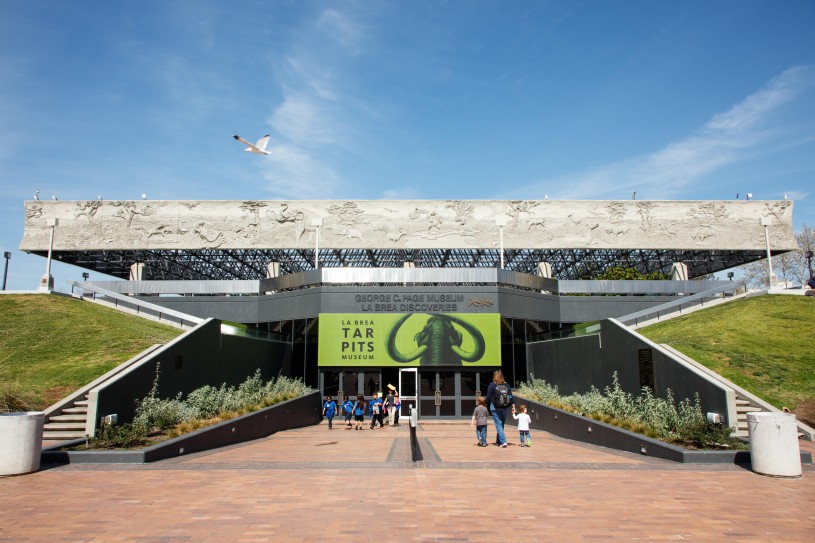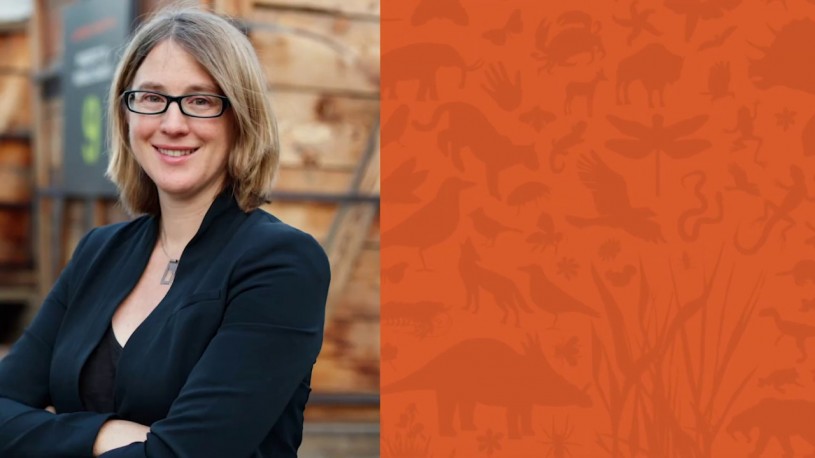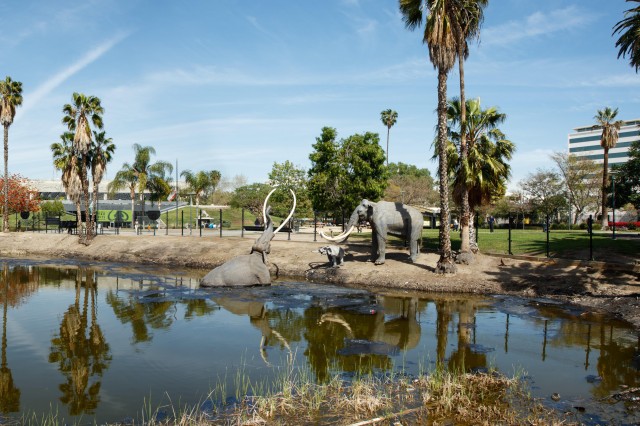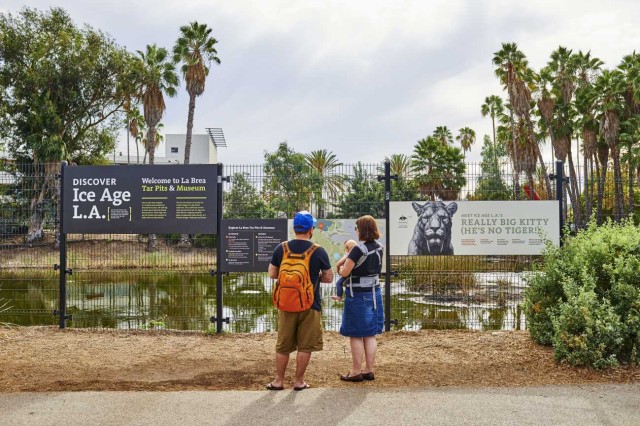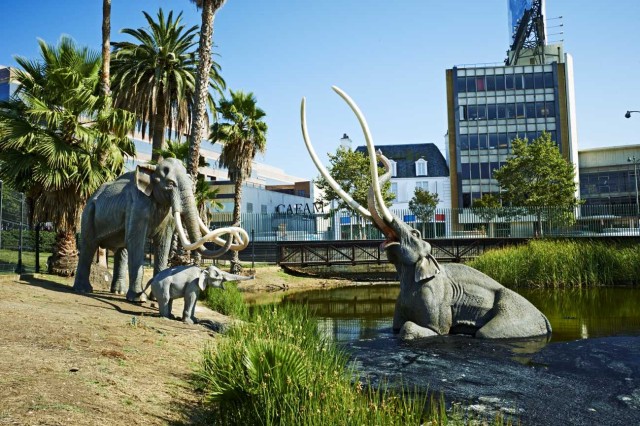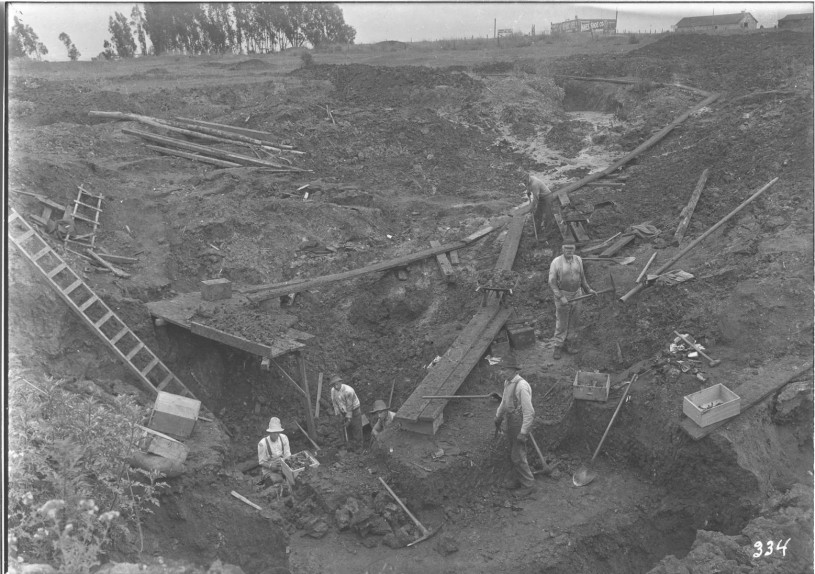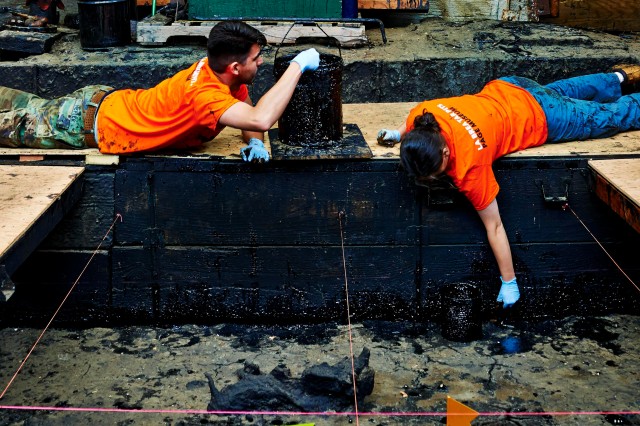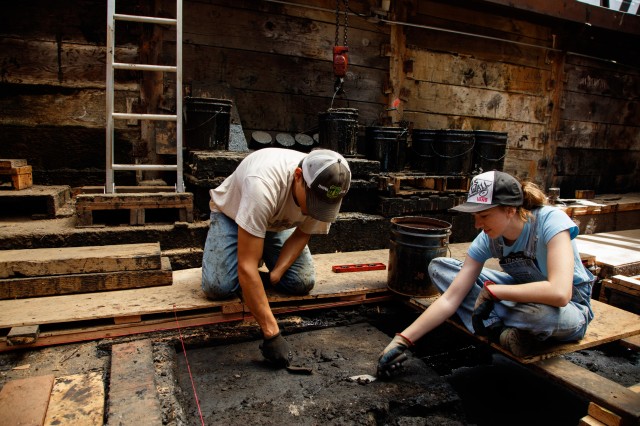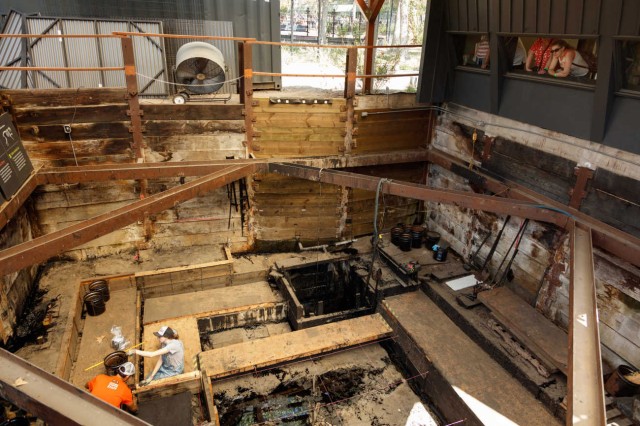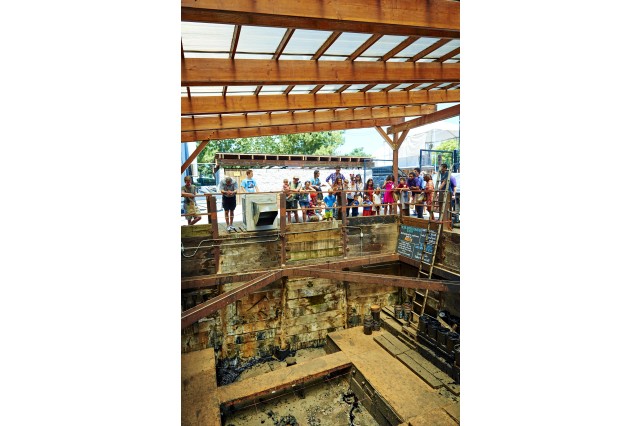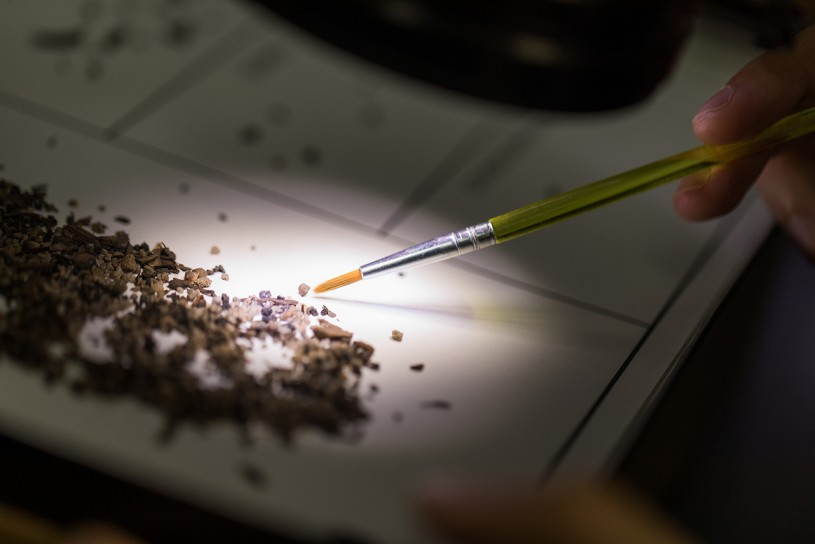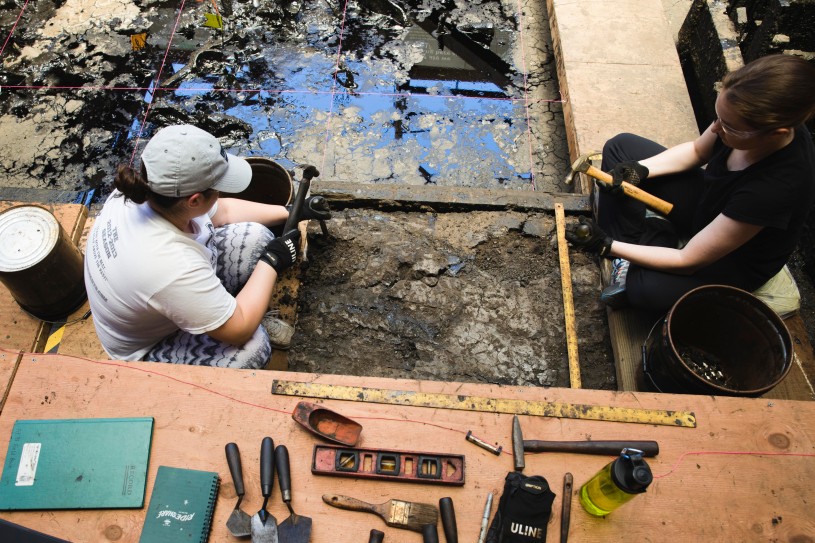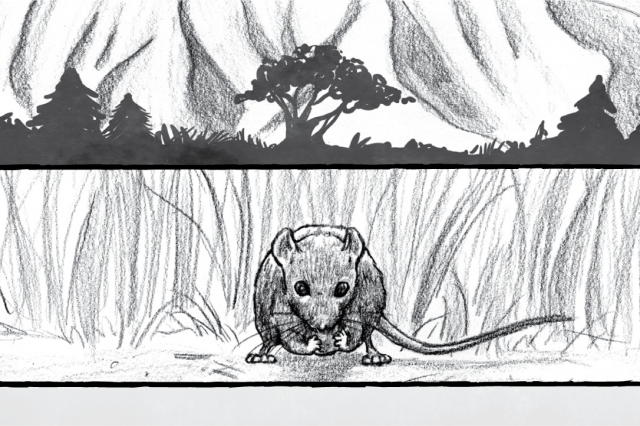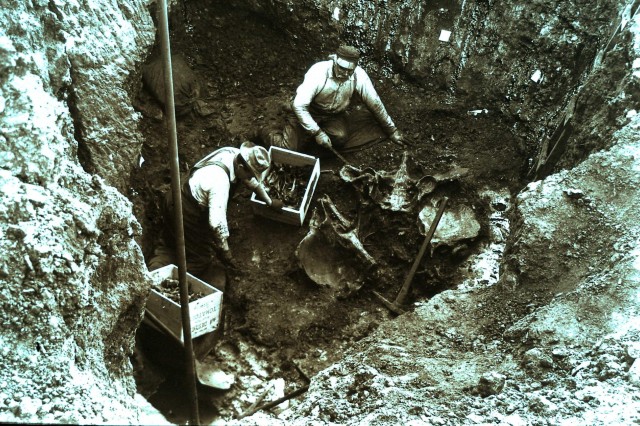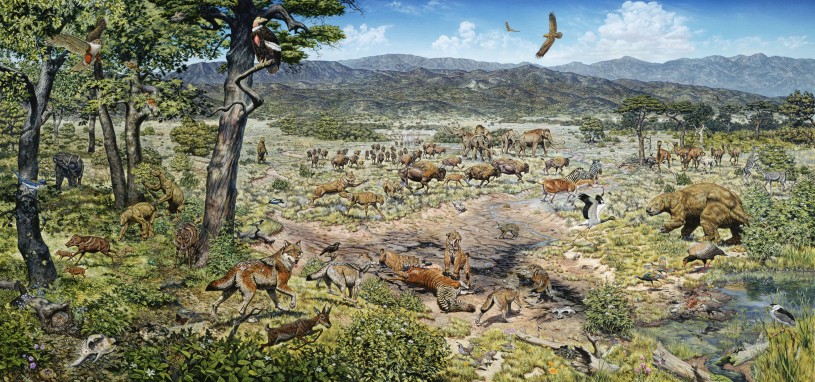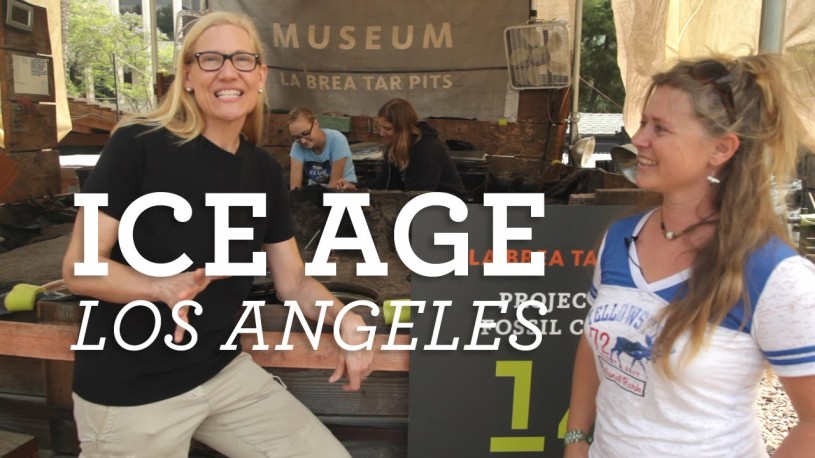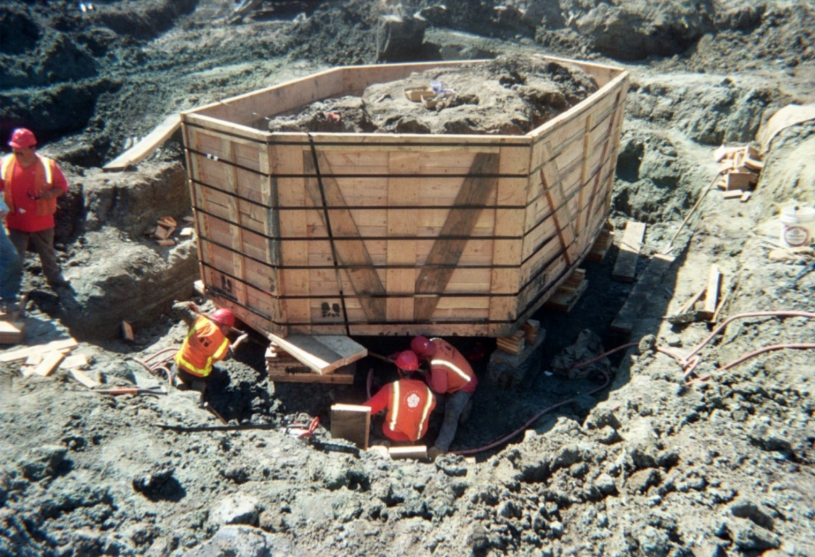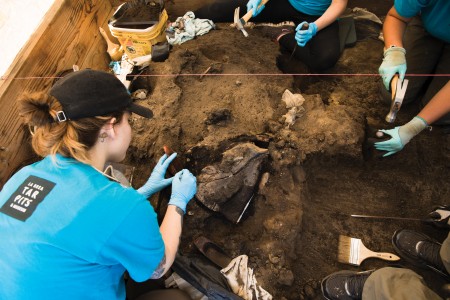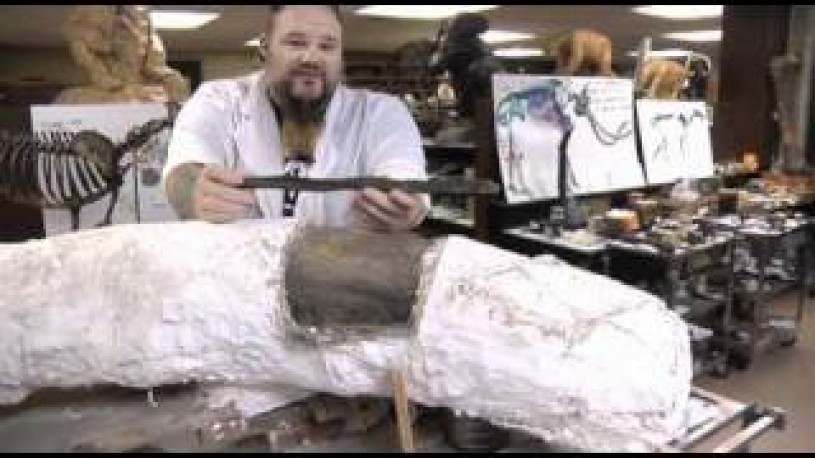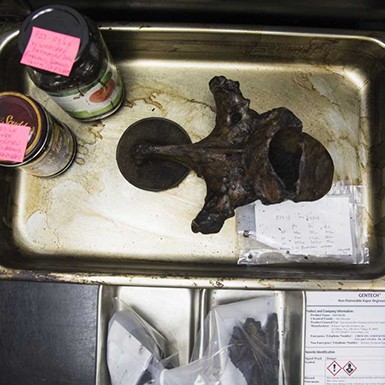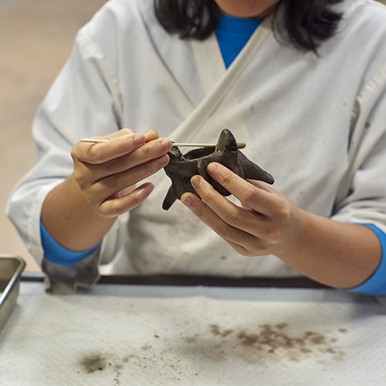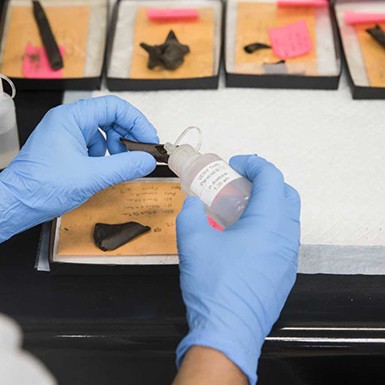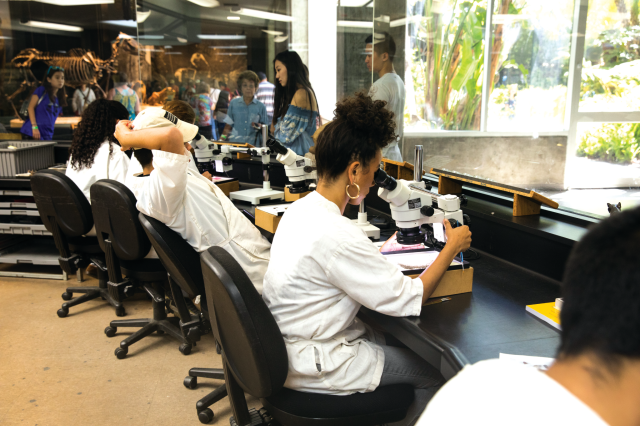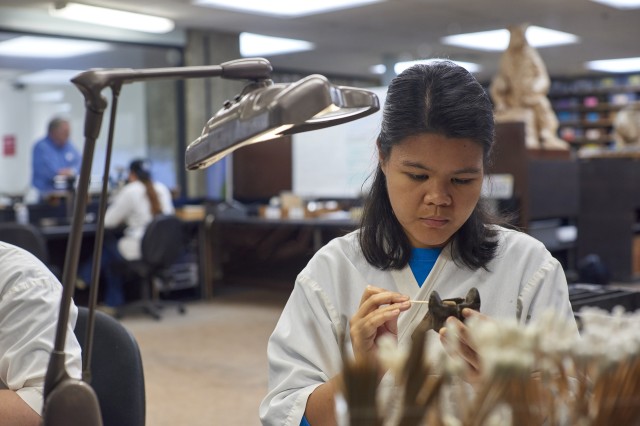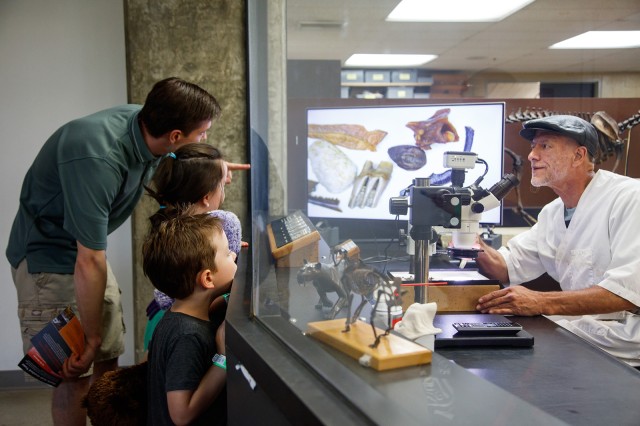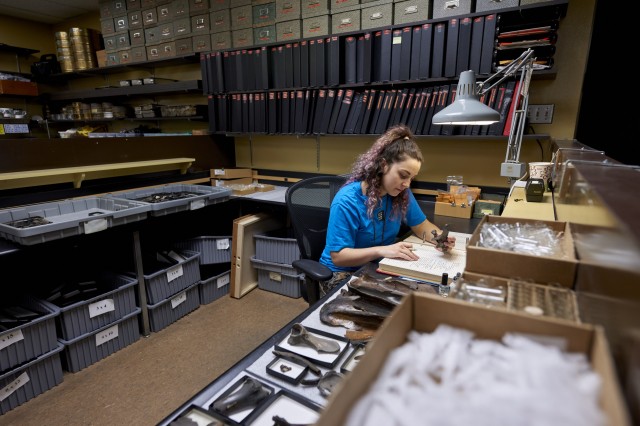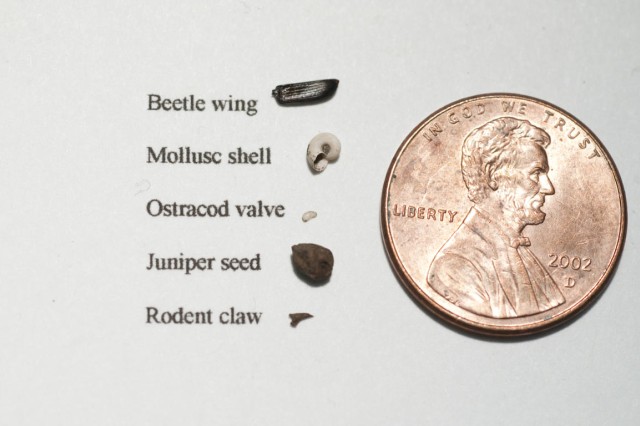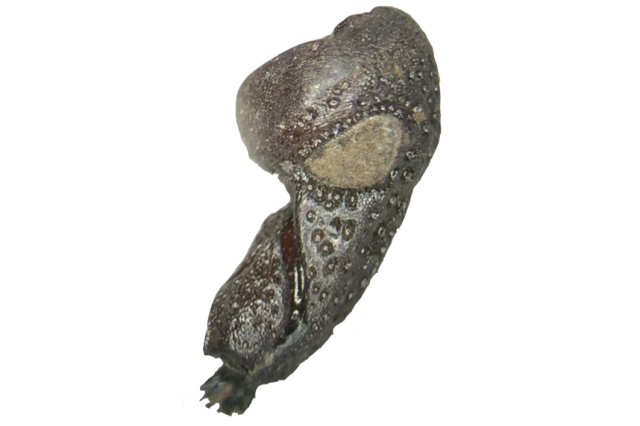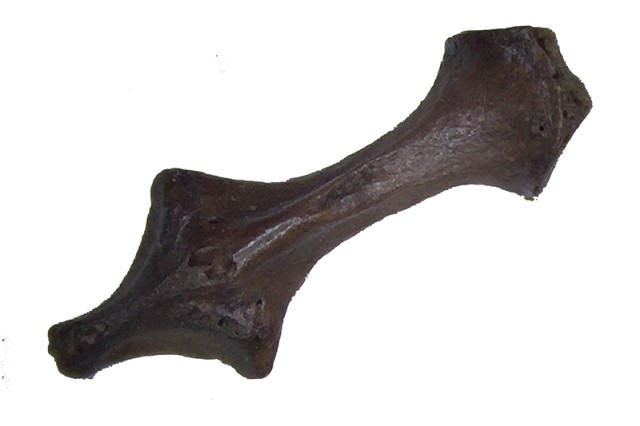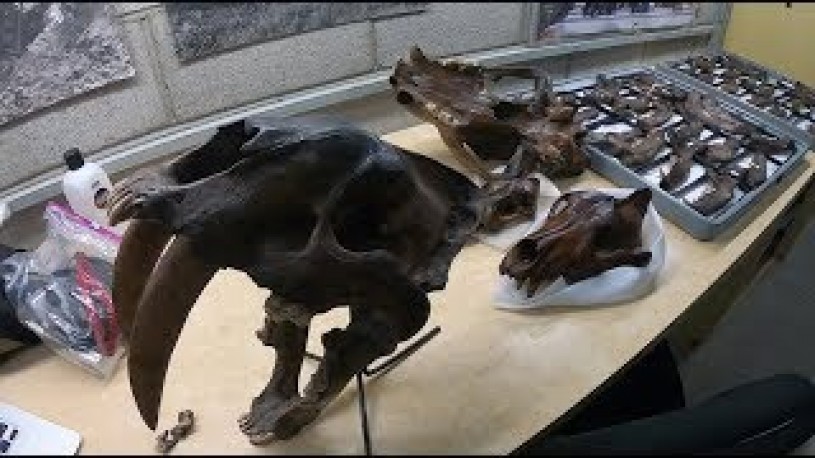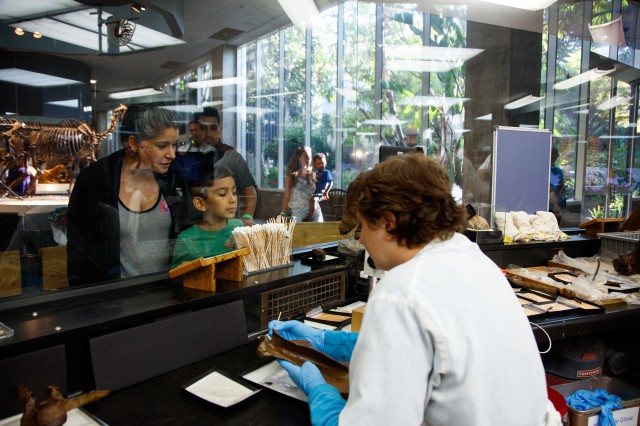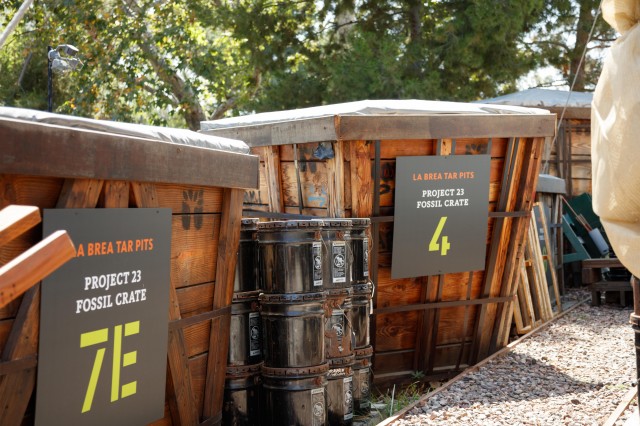Tar Pits Virtual Field Trip
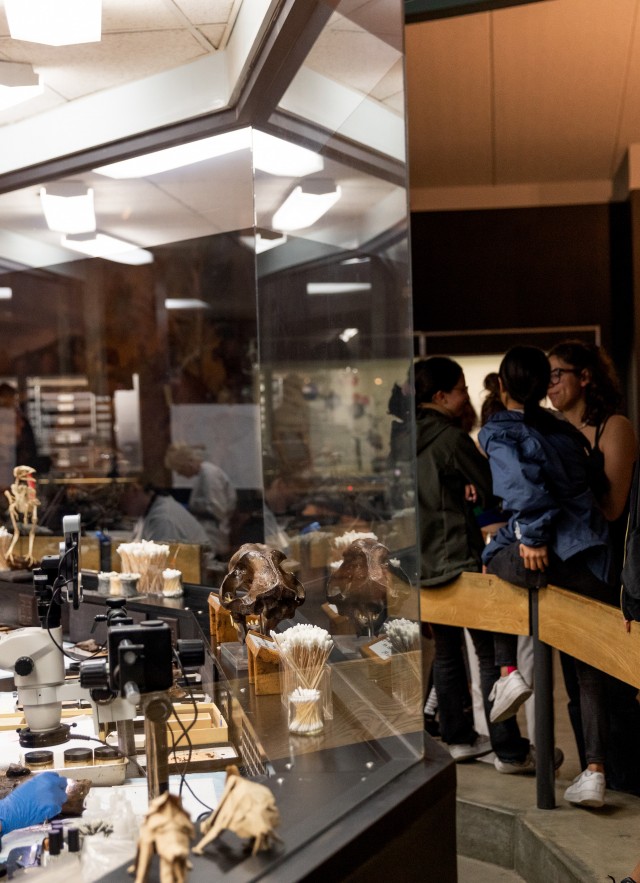
At La Brea Tar Pits, we are constantly reminded that as the process of paleontology has changed, so has our understanding of Ice Age Los Angeles.
SUGGESTED FOR GRADES 5–12
We’re glad you decided to join us on this virtual field trip! You can explore this content in a few different ways:
- Lead your class through this webpage, or have your students participate on their own devices at their own pace.
- Embark on your virtual field trip with Google Earth.
TIPS
Keep a piece of paper and pencil handy to answer prompts and participate in activities
Click on links for a deeper dive into topics
Use the table of contents links to skip around and start with what interests you
If you’re not familiar with some of the words used, definitions for words can be found in the glossary at the end
What is La Brea Tar Pits?
La Brea Tar Pits is a world-famous fossil site where excavations have been ongoing for over 100 years! At the Tar Pits, we are constantly reminded that as the process of paleontology has changed, so has our understanding of Ice Age Los Angeles.
Thanks to the work of various excavators, preparators, and scientists, we have been slowly learning more about what Los Angeles was like during the late Ice Age and finding answers to questions like:
- What animals were here during the late Ice Age?
- How did those animals interact?
- What was the landscape around those animals?
Table of Contents
Discovery and Excavation
The Lake Pit
Pit 91
Project 23
Fossil Preparation
Additional Resources
Glossary
STANDARDS
Discovery and Excavation
The Lake Pit
Active 1903–1915
An iconic part of our museum because of the family of Columbian mammoths, the Lake Pit is actually an old asphalt quarry (a large, deep pit). In the 1800s, this site was used to mine asphalt to pave L.A.’s streets and it was also the site of the very first fossil discovery!

Look at the image below of excavators in the early 1900s, and answer the questions that follow.
- What's going on in this picture?
- What tools are these individuals using?
- What more can you find?
The First Vision of Ice Age Los Angeles
The first fossils discovered here revealed a landscape of giant animals now extinct. Excavators were only finding the obvious fossils—the big ones! And their techniques reflected this: they worked in a 1 meter by 1 meter grid, digging with shovels, pickaxes, and sometimes even explosives to remove fossils. Scientists studied the fossils of these megafauna and imagined Ice Age Los Angeles as being similar to the African Savannah: tall grasses and large mammals, such as Columbian mammoths, American mastodons, Saber-toothed cats, dire wolves, antique bison, Yesterday's camels, and short-faced bears..
DID YOU KNOW?
The first fossil found was from a saber-toothed cat, identified by William Denton in 1875.
Pit 91
Active 1915, 1969–present
Pit 91 is our oldest active excavation site in Hancock Park! After resuming excavations in 1969 and some structural improvements, paleontologists realized that the matrix—the dirt and sediment surrounding the large fossils—is actually packed with microfossils!

What do you think a microfossil might be?
Why would it be important to keep and study microfossils?
What's a microfossil?
A microfossil is just what it sounds like; a very small fossil! When we excavate bones of megafauna (large animals), there is still often dirt stuck to those bones. That dirt and other dirt surrounding the megafauna bones are actually FILLED with these tiny fossils. When we examine the microfossils, we’re actually getting a better look at the “locals” of Los Angeles during the Ice Age. Think insect legs, fish scales, mouse toes, etc.
What tools do you notice in this picture?
Reopening Pit 91 allowed us to excavate with updated tools and techniques. We switched to smaller, more delicate tools to help protect both the large fossils and the microfossils. By studying these microfossils, we’re looking more closely at the plants and animals living here year-round that were more sensitive to the changes in climate, giving us a more detailed picture of the ecosystem.
Microfossils can help us construct the environment that the large animals were living in. These changes in excavation techniques have had a huge impact on our understanding of Ice Age Los Angeles!
EXCAVATION Then and Now

What do you notice about the different excavation sites above?
Make a Venn diagram to help you identify the similarities and differences in excavation practices over 100 years.
Our New Vision of Ice Age Los Angeles
Studying the fossils and microfossils from Pit 91 has greatly changed our understanding of the climate and ecosystem of Ice Age Los Angeles. The types of microfossils we’re finding suggest the climate was a bit wetter and cooler on average than today and supports the theory that there were 4 microclimates (riparian, coastal sage, deep canyon, and chaparral) spanning across the Los Angeles basin during the last 20,000 years.
DID YOU KNOW?
Digging in Pit 91 nearly doubled the number of species known from the Tar Pits and provided important data for understanding how climate change affected the habitat here, and we’re not even close to being finished with this work!
Project 23
Active 2006–present
Project 23 is unlike any other excavation project we’ve undertaken. It poses some difficult challenges, as well as great benefits that we had never encountered before. In 2006, our neighboring museum the Los Angeles County Museum of Art (LACMA) began building an underground parking lot. Fossil deposits are (of course) common in this area, but what they found was beyond expectation: 16 fossil deposits beneath the surface.
Challenges and Opportunities
How could we get out of the way of the bulldozers but save the fossils? The fossil deposits had to be carefully removed, separated into 23 boxes, and craned to the Tar Pits property, presenting some challenges but many more opportunities!
Challenges
- The Project 23 deposits are no longer in situ, or in their original position. That means that they are more exposed to the elements and are more sensitive to temperature changes and weather damage.
- How can we protect the fossil deposits from vandalism?
Opportunities
- Carefully take our time excavating, fossil by fossil.
- We can study how the fossil deposits formed by examining the sediments around the fossils.
- We can collect new kinds of fossils we can’t even see, like pollen.
- Because these are some of the oldest fossil deposits from La Brea Tar Pits, they let us compare between different time periods.
- Visitors to our park can see real paleontologists in action as we excavate these treasure troves from the past.
This project will increase the number of fossils in our collections. Having more fossils means having a larger sample size. We have the opportunity to find more rare fossils.
We built large wooden boxes around each deposit, 23 in all. The boxes were moved to their present location at La Brea Tar Pits, and excavation began on "Project 23." In addition to the boxes, there were 327 buckets of fossil material recovered from the LACMA salvage site for paleontologists to clean and sort through. It's going to keep us busy for years!

Imagine you're an engineer tasked with moving 16 fossil deposits to a new location. Design your solution answering the questions below.
- How did you address the challenges and opportunities listed above?
- What changes did you make to the museum’s solution?
- How does your new design consider the constraints (budget, time, materials, and space) of this project?
What can we learn?
Because La Brea Tar Pits is one of the only fossil sites on earth that preserves an entire ecosystem - from tiny seeds and insects to giant sloths and mammoths - it can tell a detailed story of climate change, adaptation, and extinction at the end of the Ice Age.
Learning about how the environment changed during the Pleistocene is crucial for understanding more about why the megafauna went extinct.
Were important food sources affected by changing climate?
Did access to water sources change?
Why did some big animals survive the extinctions?
Excavation Review
The work doesn’t stop with excavation! All of the fossils excavated out here—big and small—eventually make their way into the museum where they are cleaned, sometimes repaired, and prepared for study or exhibition in our collections.
Before heading into the Fossil Lab, let’s recap what we have learned from the excavations done right here in Hancock Park over the last century:
Early excavators concentrated their efforts on the remains of the larger fossils, building up our understanding of what megafauna were here.
Reopening Pit 91 shifted our focus to also look for microfossils, which revealed that the environment was cooler and wetter than today, and had more biodiversity than initially thought.
Even with all we've learned, there is still more work to be done, and more questions to be answered. With our new techniques and a new excavation site, we have a great deal of learning ahead of us.
Fossil Preparation
Fossil Lab: Paleontology in Action
In the Fossil Lab, you can see paleontologists work to clean, sort, study, and catalogue fossils every day, continuing to open a window to the past.
Check out this behind-the-scenes look at our Fossil Lab!
How to Clean a Fossil in 3 Steps
1. Remove the asphalt (a highly viscous or gooey, black, tar-like substance). Hardened asphalt is carefully removed by soaking the bones in a solvent (n-propyl bromide) overnight.
2. A second cleaning session removes any residual clay and silt using water and foam tip applicators. Larger fossils, and fossils with many cavities such as skulls and vertebrae, can sometimes take several days to clean completely. Every fossil discovered in the Tar Pits has a characteristic brown hue as a lasting stain from the asphalt.
3. Broken fossil? No problem! Sometimes specimens can become damaged or cracked during the fossilization process. In the Fossil Lab, the team can repair or reconstruct the bone using a transparent, glue-like adhesive (Paraloid B-72). After each bone is cleaned, and repaired if it’s necessary, it is then transferred to our collections team.
Microfossil Sorting
Microfossils are tiny fossils less than 1cm in size, such as teeth, bones, plants, insects, shells, and more. They are found in the matrix (sediment) that was excavated around the large fossils, or removed during the fossil cleaning process. Our staff and volunteers peer through microscopes and patiently sort through the matrix, grain by grain. These microfossils offer our scientists a wealth of knowledge about the past environments and climate of Ice Age L.A. during the late Pleistocene epoch.
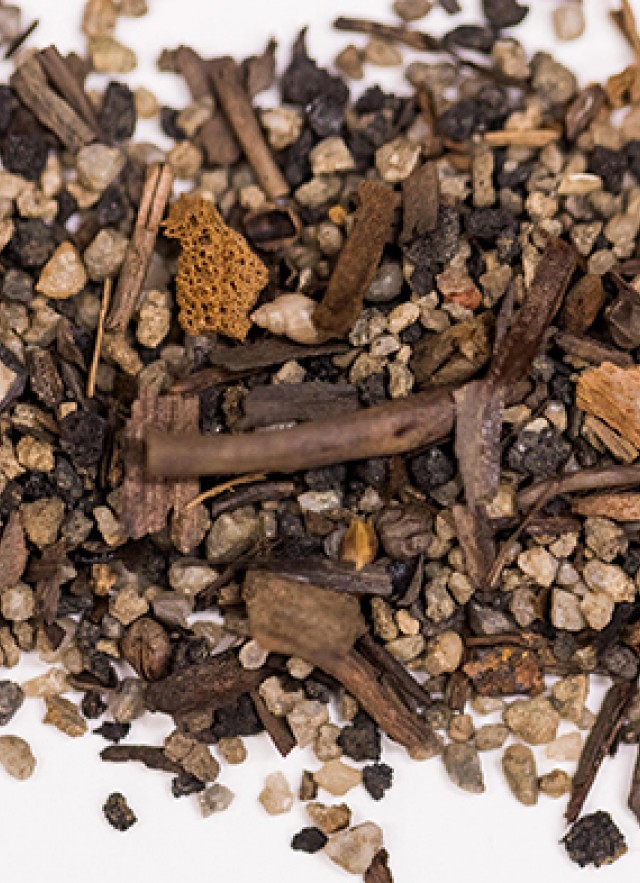
These are just some of the microfossils we've found in our excavations. Sometimes the smallest finds have the biggest impact!
Research at the Fossil Lab
We host researchers from around the world. Their work uses our collections to try to answer some of the many questions we still have about the animals and environment during the Ice Age.
Check out this video of Dr. Larisa DeSantis, one of the many researchers who has used our collections to expand our understanding of the survival and extinction of predators like saber-toothed cats and dire wolves in Ice Age Los Angeles!
Additional Resources
Need to know more about paleontology at the Tar Pits? We’ve got you covered. Check out the links below to continue exploring!
- We excavate at the Tar Pits 361 days a year, but our scientists also travel around the world conducting research on evolution, climate change, and extinction. Some of these expeditions are to other Tar Pits of the World.
- Explore more about the ecosystems of Ice Age Los Angeles with Dr. Emily Lindsey!
- Check out this video that demonstrates how we practice paleontology with a full overview!
- Ever heard of paleoforensics? Check out how our scientists can study evidence of injuries to learn more about the dynamic social behaviors of Ice Age animals.
- What can bones tell us about climate change?
- Check out the Paleontological Research Institute for more fossil fun!
- Step inside Project 23, our current excavation site, in this virtual field trip presented by NOVA.
- Return to the Ice Age with our study guide all about the Tar Pits.
- Print our Process of Paleontology sequencing game to test your knowledge (Psst… answer key here!)
- Want details of all the species we’ve found at the Tar Pits? Check out our Collections page!
Glossary
Climate
Describes the weather conditions of a place over a long timespan; including patterns of temperature variation, humidity, wind, precipitation, etc.
Ecosystem
A biological community of interacting organisms and their environment.
Epoch
A period of time in history, typically one marked by notable events or particular characteristics.
Excavation
The act or process of digging, especially when something specific is being removed from the ground.
Extant
Describes an organism that is still living.
Extinct
Describes an organism with no living members.
Fossil
Any preserved evidence of ancient life. This can be anything from a skeleton to a footprint, or even a leaf! Ancient is usually defined as being at least 10,000 years old.
Matrix
The dirt or sediment surrounding a fossil.
Megafauna
Large mammals of a particular region, habitat, or geological period.
Microfossil
A fossil or fossil fragment only visible using a microscope.
Paleontology
The science which studies the history of life on Earth by examining fossil evidence.
Pleistocene
Describes a time period that lasted from about 2,588,000 to 11,700 years ago comprising a series of "Ice Ages"; the one represented at the Tar Pits is just the last one.
Preparator
The person responsible for preparing paleontological specimens for study or exhibit; this includes excavation, cleaning, repairing, etc.
Standards
Next Generation Science Standards
Disciplinary Core Ideas: ESS1.C, ESS3.C, LS1.D, LS2.A, LS2.C, LS2.D, LS4.A, ETS1.A, ETS1.B
Science & Engineering Practices: 1, 2, 4, 6, 7, 8
Cross-Cutting Concepts: 2, 4, 7
Common Core State Standards
English Language Arts: RI.5.4, RI.6.4, RI.7.4, RI.8.4, RI.9-10.4, RI.11-12.4, RST.6-8.1, RST.9-10.1, RST.9-10.4, RST.11-12.1, W.5.8, W.5.9, W.6.7, W.7.7. W.8.7
